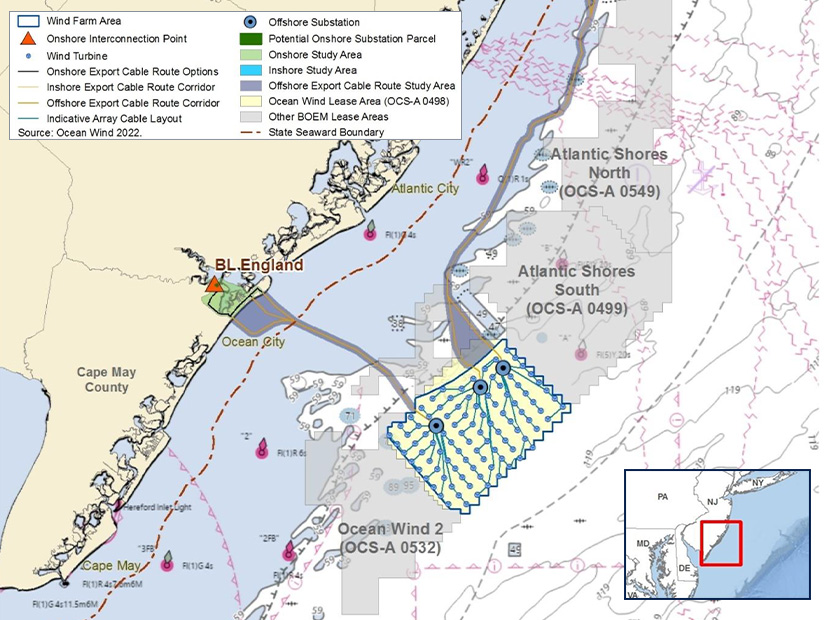The first draft environmental impact statement (DEIS) released by the U.S. Bureau of Ocean Energy Management (BOEM) for New Jersey’s first offshore wind project, Ørsted’s Ocean Wind 1, found that it would not have a major impact on most of the 19 environmental and related categories scrutinized.
But the 1,408-page report released Friday also found that the construction and installation, operations and maintenance, and eventual decommissioning of the project would certainly have a major impact on marine navigation and vessel traffic.
The report assessed the impact on four levels: negligible, minor, moderate and major. Categories that could experience up to a major impact are the scenic view, fishing sector and marine mammals; they could also experience negligible to minor impacts, the DEIS found.
The project could also have negligible to moderate impact on birds, sea turtles and recreation and tourism, as well as benthic resources, the sediments at the seafloor that provide nutrients for some sea organisms.
The release of the report triggers a 45-day public comment period that begins June 24, with public hearings on July 14, 20 and 26. BOEM will consider those comments in preparation for the final EIS, which could include recommendations or requirements to mitigate the project’s major impacts.
Shawn LaTourette, commissioner for the New Jersey Department of Environmental Protection, called the release of the DEIS “a significant milestone in the evaluation of the first offshore wind project off the coast of New Jersey.”
“Over the coming weeks DEP will thoroughly evaluate and provide comment on the DEIS to ensure the project has taken all steps necessary to avoid potential adverse impacts to New Jersey’s natural, historic and cultural resources,” he said in a release. The DEP said it expects the final EIS to be released in March 2023. Gov. Phil Murphy said the release of the DEIS brings New Jersey “one step closer to bringing its vision for a more sustainable future to fruition.”
Most Impacted
The DEIS said the impacts to marine navigation and traffic would include “changes in navigation routes, delays in ports, degraded communication and radar signals, and increased difficulty of offshore [search and rescue] or surveillance missions within the wind farm area, all of which would increase navigational safety risks.”
But most of the opposition to Ocean Wind 1 has been from local residents concerned about its potential harm to their view of the sea and from the commercial and leisure fishing sector, which fears that the turbines will damage marine life and impair their ability to fish. The tourism sector has said the site of turbines on the horizon will also harm the industry.
The DEIS said the impact of the project on commercial fishing would vary, and that the “majority of vessels would only have to adjust somewhat to account for disruptions due to impacts.” However, the report added, “it is conceivable that some of the small number of fishing operations that derive a large percentage of their total revenue from areas where project facilities would be located would choose to avoid these areas once the facilities become operational.”
“In the event that these specific fishing operations are unable to find suitable alternative fishing locations, they could experience long-term, major disruptions,” the report added.
The draft also said that “the daytime presence of offshore [turbines and substation], as well as their nighttime lighting, would change perception of ocean scenes from natural and undeveloped to a developed wind energy environment.” The project’s facilities “would be an unavoidable presence in views from the coastline, with moderate to major effects on seascape character and landscape character.”
The project would also “result in habitat disturbance (presence of structures and new cable emplacement), underwater and airborne noise, vessel traffic (strikes and noise), and potential discharges/spills and trash.”
Doug O’Malley, director for Environment New Jersey, said his organization’s biggest concern is the impact on marine life.
“The goal of offshore wind is to maximize clean, renewable energy and minimize environmental impacts,” he said. “This is early days. But the DEIS is clearly outlining how the project can maximize clean energy and minimize true environmental impacts.
“Offshore wind will clearly impact marine traffic and fishing, but, you know, we desperately need to clean, renewable energy from offshore wind,” he said.
The 1,100-MW Ocean Wind 1 project, approved by the New Jersey Board of Public Utilities in 2019, was the first of three offshore wind projects approved, totaling about half the state’s target of 7,500 MW by 2035. The other two, the 1,148-MW Ocean Wind 2 and the 1,510-MW Atlantic Shores, were approved in June 2021. The state expects the first of three more solicitations to begin early in 2023. (See NJ Awards Two Offshore Wind Projects.)
BOEM released the Ocean Wind 1 DEIS as the BPU evaluates an application by the project for an easement in Ocean City, where some transmission lines from the project would come ashore. The BPU will hold a public hearing on the issue Friday. (See Ørsted NJ Wind Project Faces Local Opposition.)
Offshore Wind 1 is projected to include 98 turbines with a maximum height of 906 feet at the top of the rotator blade tip. It is expected to come online in 2024.
Ørsted said the DEIS marks a “critical and exciting permitting milestone” for the project. The company looks forward to “reviewing it in detail as we begin a robust public engagement process over the coming weeks.”
The aim of the DEIS is to “assesses the reasonably foreseeable impacts on physical, biological, socioeconomic and cultural resources that could result” from the project, according to its introduction. The report will inform BOEM’s decision on “whether to approve, approve with modifications or disapprove the project.”
Other federal agencies also will use the report to inform their evaluation of the project, including the National Marine Fisheries Service and the U.S. Army Corps of Engineers.


